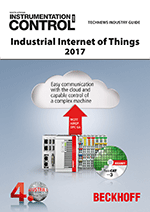
Welcome to another bumper edition of Motion Control. The latest Technews industry guide from our sister publication, South African Instrumentation and Control, is Industrial Internet of Things 2017. Editor, Steven Meyer says that the goal for this guide is to cut through the hype and reveal what IIoT is really all about, and how easy it is for companies to get started with data they may already have, as there are some very real benefits to be had. The IIoT Guide is well worth a read and is available online at http://motioncontrol.co.za/*iiot17.
I am fascinated by a new IIoT concept that is emerging, the digital twin. Listed as one of Gartner’s Top 10 Strategic Technology Trends for 2017, this is a virtual recreation of a physical asset, maintained throughout the product lifecycle. It is conceived along with the product idea, serves as a virtual template for production, grows and develops in the product creation phase and remains joined with the physical product throughout its lifecycle. Digital twins use data from sensors installed on physical objects like actuators, sensors, drives, robots and conveyor belts to represent their status, working condition or position.
The concept of a digital twin has been around since 2002, where it was used in NASA’s space programmes. However, it is only with the advent of IIoT that the technology has become cost-effective to implement. NASA’s ultimate vision is to create, test and build all its equipment in a virtual environment. Only when it performs to requirements is it physically manufactured. The physical version is linked through sensors to its digital twin, which contains all the information that could be gained by manually inspecting the physical version. NASA now uses digital twins to develop next-generation vehicles and aircraft.

The potential savings are enormous. The power of a digital twin is that it allows analysis of data and monitoring of systems to head off problems before they occur. Problems in design and manufacturing can be identified and bottlenecks can be improved without ever committing a physical resource. This knowledge is incredibly powerful because it allows you to prevent downtime, develop new opportunities and plan for the future by using simulations. IDC Futurescape predicts that by 2018, companies investing in digital twin technology will see a 30% improvement in cycle times of critical processes.
Common uses for digital twin technology already include machine and equipment health and predictive maintenance. Digital prototypes are another powerful application. Developers can avoid the expense of physical prototypes and endless testing iterations by using digital twinning to run through a wide range of scenarios in a very short time, develop and screen solution strategies and implement improvements. As another example, an in-line digital twin can allow operators to train on a virtual machine until they have the skills needed to operate the real machine without the expense of a dedicated training simulator.
The frontrunners are already embracing this idea. Siemens runs months of production in a digital simulation and has revolutionised its commissioning process on 320 plants. Its electronics factory in Amberg, Germany, makes 1 million units a month. Since digitising, the company has reduced 200 defects/million to just 10. In another example, General Electric piloted a digital windfarm concept that uses a real-time simulation and modelling system to predict problems and optimise daily power production. The company says it could boost a farm's energy production by up to 20%; and the company’s aircraft system collects terabytes of data per engine in the course of a flight, generating real-time digital twin of each engine. If a potential fault is detected, the maintenance personnel can have the necessary replacement part ready and waiting.

Schneider Electric is another early adopter and talks about its first-born digital twin. As part of the process design, a model is created to simulate the plant before it is even built - the first-born digital twin. This enables engineers to test a physical asset before anything is constructed. It allows for the process, equipment and operations to be analysed and optimised for safety, reliability and profitability. Schneider then gives birth to the physical asset twin. Once this is up and running, the connection between the digital twins continues as operations are continuously monitored, adjusted and optimised, based on real-time data collected from sensors around the plant.
Kim Roberts
Editor
Motion Control
| Tel: | +27 11 543 5800 |
| Email: | [email protected] |
| www: | www.technews.co.za |
| Articles: | More information and articles about Technews Publishing |

© Technews Publishing (Pty) Ltd | All Rights Reserved